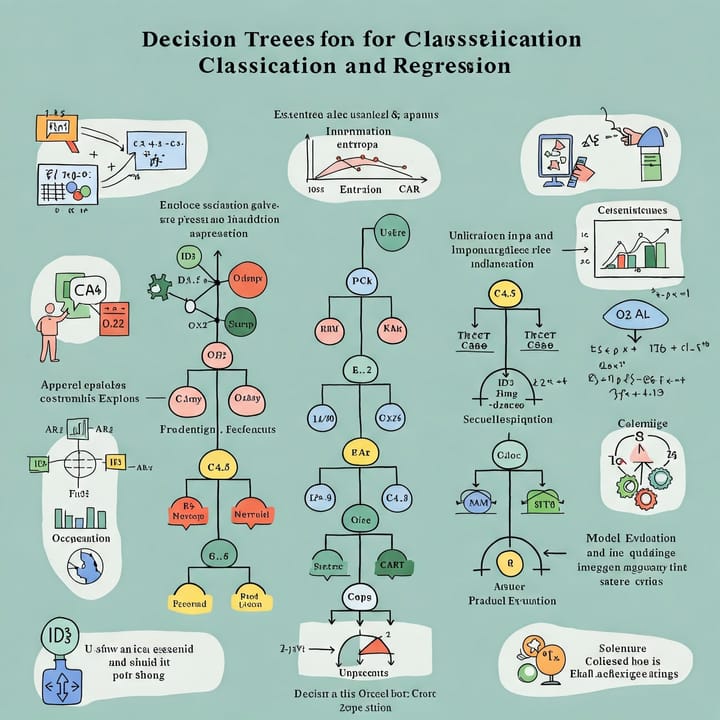Bias-Variance Tradeoff: A Fundamental Concept in Model Selection
The bias-variance tradeoff is a central concept in supervised machine learning that describes the relationship between a model's complexity, its ability to fit the training data, and its ability to generalize to unseen data. Understanding this tradeoff is crucial for choosing the right model and achieving optimal performance. It's a balancing act: we want a model that's complex enough to capture the underlying patterns in the data, but not so complex that it overfits the training data and performs poorly on new data.
1. What are Bias and Variance?
To understand the tradeoff, we first need to define bias and variance:
- Bias: Bias refers to the error introduced by approximating a real-world problem, which is often very complex, by a simplified model. A model with high bias makes strong assumptions about the data, and these assumptions may be incorrect. This leads to systematic errors, where the model consistently misses the true relationship between the input features and the target variable. High bias often results in underfitting – the model is too simple to capture the underlying patterns.
- Example: Imagine trying to fit a straight line (linear regression) to data that actually follows a curved (e.g., quadratic) relationship. The linear model will have high bias because it's fundamentally unable to capture the curvature. It will consistently underestimate or overestimate the target variable in certain regions.
- Variance: Variance refers to the amount by which the model's predictions would change if we trained it on a different training dataset. A model with high variance is very sensitive to the specific training data it receives. Small fluctuations in the training data can lead to large changes in the model's predictions. High variance often results in overfitting – the model learns the noise and random variations in the training data, rather than the true underlying relationship.
- Example: Imagine fitting a very high-degree polynomial to a small dataset. The polynomial might perfectly interpolate all the training data points (including any noise), but it would likely oscillate wildly between those points and perform poorly on new, unseen data. The model has "memorized" the training data rather than learning the general pattern.
2. The Tradeoff
The bias-variance tradeoff arises because, generally:
- Increasing model complexity decreases bias but increases variance. More complex models (e.g., high-degree polynomials, deep neural networks with many layers) can capture more intricate patterns in the data, reducing bias. However, they are also more prone to overfitting the training data, leading to high variance.
- Decreasing model complexity increases bias but decreases variance. Simpler models (e.g., linear regression, shallow decision trees) make stronger assumptions about the data, increasing bias. But they are less sensitive to the specific training data, leading to lower variance.
The goal is to find the "sweet spot" – the optimal level of model complexity that minimizes the total error, which is a combination of bias and variance.
3. Visualizing the Tradeoff
A common way to visualize the bias-variance tradeoff is with a graph:

- Low Complexity (Left Side): High bias, low variance. The model underfits the data.
- High Complexity (Right Side): Low bias, high variance. The model overfits the data.
- *Optimal Complexity (The "Sweet Spot" - ): The point where the total error is minimized. This is the best balance between bias and variance.
4. Mathematical Formulation (Optional, but Illuminating)
The total expected error of a model can be decomposed into bias, variance, and irreducible error:
Expected Error = Bias² + Variance + Irreducible Error
- Bias²: The squared bias represents the systematic error due to the model's simplifying assumptions.
- Variance: The variance represents the error due to the model's sensitivity to the training data.
- Irreducible Error: This is the error that cannot be reduced by any model, no matter how complex. It represents the inherent noise in the data or limitations in the features themselves. We can't control this.
Our goal is to minimize the sum of Bias² and Variance.
5. Practical Implications and Strategies
Understanding the bias-variance tradeoff helps us make informed decisions about model selection and training:
- Detecting High Bias (Underfitting):
- High training error.
- High validation/test error (similar to training error).
- Solutions:
- Increase model complexity (e.g., add more features, use a more complex model like a polynomial or neural network).
- Try different algorithms.
- Gather more relevant features.
- Detecting High Variance (Overfitting):
- Low training error.
- High validation/test error (much higher than training error).
- Solutions:
- Regularization: Add a penalty term to the loss function that discourages complex models (e.g., L1 or L2 regularization).
- Reduce Model Complexity: Use a simpler model (e.g., fewer layers in a neural network, lower-degree polynomial).
- More Data: Increasing the size of the training dataset can often reduce variance.
- Feature Selection: Remove irrelevant or redundant features.
- Cross-Validation: Use techniques like k-fold cross-validation to get a more reliable estimate of the model's generalization performance.
- Data Augmentation Increase size of training set by augmenting.
- Dropout (for neural networks): Randomly drop out neurons during training to prevent co-adaptation.
- Early Stopping: Monitor the model's performance on a validation set during training and stop training when the validation error starts to increase.
- Choosing the Right Model:
- Start with a simple model (e.g., linear regression) and gradually increase complexity if needed.
- Use cross-validation to compare the performance of different models and hyperparameter settings.
- Consider the bias-variance tradeoff when selecting a model. There's no universally "best" model; it depends on the specific problem and dataset.
6. Examples
- Linear Regression vs. Polynomial Regression: Linear regression has high bias (unless the data is truly linear) and low variance. Polynomial regression can have low bias (if the degree is high enough), but high variance if the degree is too high.
- Shallow vs. Deep Decision Trees: Shallow trees have high bias and low variance. Deep trees can have low bias but high variance.
- Small vs. Large Neural Networks: Small networks have high bias and low variance. Large networks can have low bias but high variance.
7. Conclusion
The bias-variance tradeoff is a fundamental concept in machine learning that guides model selection and helps us build models that generalize well to unseen data. By understanding how bias and variance contribute to the overall error, and by employing techniques to manage this tradeoff, we can create more accurate and reliable machine learning models. There is no one "correct" level of bias or variance, but rather a balance that needs to be achieved depending on the specific problem and dataset. The key is to find the model complexity that minimizes the total error, leading to the best possible performance on new, unseen data.
Some useful links:



Comments ()